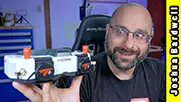Basically, all of the links on this page are affiliate links. I receive a commission (at no extra cost to you) if you make a purchase after clicking one of the affiliate links below. Read our Affiliate Link Policy for more information.
If this will be your first time ordering from Banggood, you should know a few things.
Once upon a time, analog video was the only way to fly FPV. It was low resolution and had breakup and static, just like old broadcast TV. At least it was inexpensive. But lots of people wondered: why can’t we have digital HD systems for FPV like we do for everything else? Today, we can. All of the video systems on this page transmit at least 720p resolution with digital signals, so you can finally enjoy FPV with an image quality that looks like something out of this century!
This page is going to compare and contrast HD video systems from DJI, Walksnail, and HDZero. The assumption here is that you’ve decided to go with a digital system and you’re just trying to figure out which one is best for you.
What if you’re still on the fence about analog? Here’s who might still be best served by analog video today.
- Analog cameras, video transmitters, and goggles can be between one-third and one-fifth of the cost of digital. People on the tightest of budgets should still choose analog video.
- If you’re serious about racing, analog might be best for you. It’s cheaper to outfit a fleet of racing quads with analog. Analog has low, consistent latency, which makes more and more of a difference the faster and more precisely you fly. Analog works perfectly with race timing systems and DVRs used at large races.
- If you’re REALLY serious about racing, you should seriously consider HDZero. It has all of the desirable characteristics of analog, but with even better digital image quality. Downside? It’s more expensive and not quite as durable. The majority of top racers have switched from analog to HDZero, and many feel it gives them a competitive advantage.
- If you fly primarily drones from about 95mm wheelbase and down, or with a weight of about 150 grams or less, then analog may be best for you. Analog vTX is much lighter and smaller than DJI and Walksnail. However, HDZero has a vTX specifically designed for small quads that is similar in weight and size to analog vTX. Walksnail also has a light vTX that can work on smaller drones. But especially if you’re shopping for bind-n-fly drones, analog will give the widest variety of choices.
If you don’t fit into one of the above categories, then there’s a very good chance you will be happiest with one of the digital systems described on this page.
The DJI FPV System v2 refers to the DJI FPV Goggles and DJI FPV Goggles v2, which work with the DJI Air Unit, Caddx Vista, and Runcam Link video transmitters. The successor to the FPV Goggles V2 is the (enragingly named) DJI Goggles 2 which is covered in a separate section of this page.
In 2024, The V2 DJI FPV system is finally coming to an end. The V2 goggles are basically impossible to buy new, and even used/refurbished sources are getting more and more rare. As a result, we have removed the V2 DJI goggles from this page. However, the V2 section still remains because V2 video transmitters are widely available, and they still work with the Goggles 2. These cameras are still desirable even though they are last-generation because they offer capabilities like low-light vision that the O3 camera does not.
Most people who want to get into the DJI FPV system today should buy the Goggles 2, the Integra goggles, or whatever goggle DJI releases after that.
The first thing to do when shopping for a DJI V2 system is choose a camera. DJI V2 cameras are made by Runcam and Caddx. Once up on a time, DJI made cameras for the V2 system, but they’ve stopped. Whichever camera you settle on, the good news is that both Runcam and Caddx sell the exact same DJI video transmitter under a different name (Caddx calls it the Vista while Runcam calls it the Link). This vTX is the only one currently available for the DJI V2 cameras, so your choice is simple.
The main distinction between cameras is whether they support 120fps or 60fps refresh rate. The 120fps cameras have lower latency of about 25 to 35 ms, while the 60fps cameras are more like 35-45 ms. Pilots disagree over whether this small difference matters. It depends a lot on the type of flying you do. Although it’s not directly related to the framerate, 120fps cameras can also adjust image settings like exposure, saturation, and white balance. They can also switch between 4:3 and 16:9 aspect ratio; all of the 60 fps cameras are a 16:9 aspect ratio only. Unfortunately, not all 120fps cameras have this feature any more, so you should check product listings carefully if this is a feature that’s important to you.
120 fps cameras include the original DJI camera and the Caddx Nebula Pro. These have the best image quality, in addition to the other advantages of their high framerate. Caddx has also released the Nebula Pro Nano, which is a 14mm (nano-sized) 120 fps camera for the smallest drones. Image quality isn’t quite as good as its larger cousin, but it’s the best 14 mm-sized DJI camera you can get. Make sure you DON’T buy the Nebula Nano (vs. the Nebula Pro Nano), as the Nebula Nano (non-Pro version) has very poor image quality.
If you’re ok with a 60 fps camera, then you’ll choose based on image quality and size/weight. The Caddx Polar and Runcam Phoenix HD both have worse image quality than the 120fps cameras, but still acceptable to some. Neither one is clearly superior to the other, and you should compare them in reviews to decide which one you prefer.
For night-time use, the Caddx Polar and the Runcam Night Eagle have great low-light sensitivity.
The Runcam Wasp deserves special mention. It’s a 120fps camera, so it has lower latency, but it’s the only 120fps camera that doesn’t have adjustable image settings (exposure, saturation, etc) and it only operates in 4:3 mode. It also can’t switch from the 120fps low latency mode to the 60 fps high-quality mode. Basically, if you only fly in low latency mode, and you’re ok with a 4:3 aspect ratio, the Wasp is an acceptable choice, but the Nebula Pro not that much more expensive and has better image quality and adjustability.
When shopping for a camera, pay attention to whether it’s labeled as “micro” or “nano”. Micro cameras are 19mm wide; nano cameras are 14mm wide. Most modern frames from about 3″ on up are sized for Micro cameras, but if you buy a Nano camera, you can use a 3d printed adapter to mount it. Nano cameras are typically used on frames smaller than 3″.
CADDX NEBULA PRO MICRO VISTA
(120 FPS)
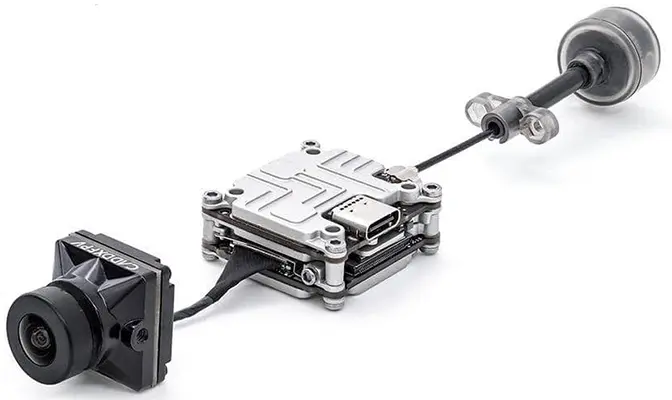
Find this product at these vendors:
CADDX NEBULA PRO NANO VISTA
(120 FPS)
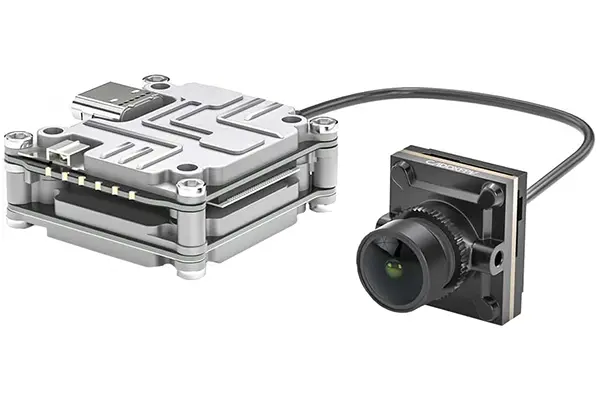
Find this product at these vendors:
CADDX POLAR VISTA
(60 FPS)
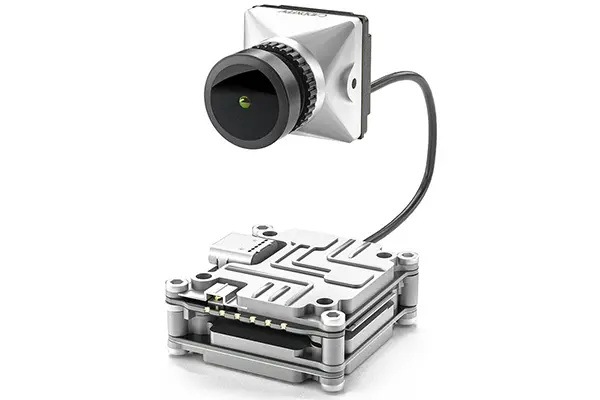
Find this product at these vendors:
RUNCAM WASP
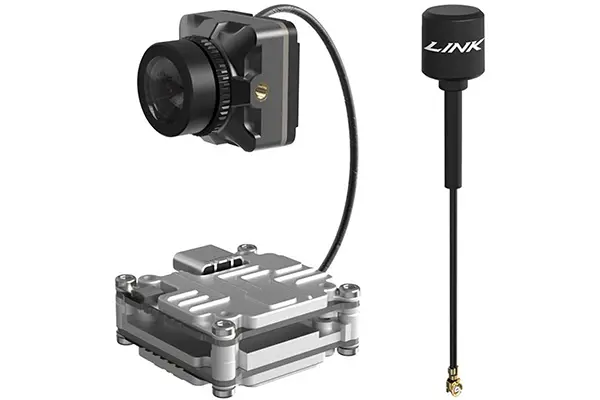
Find this product at these vendors:
Purchase at RaceDayQuads – RunCam Link / DJI Air Unit
Purchase at GetFPV – RunCam Link / DJI Air Unit
Purchase at Rotor Riot – RunCam Link / DJI Air Unit
Purchase at ReadyMadeRC – RunCam Link / DJI Air Unit
Purchase at Banggood – RunCam Link / DJI Air Unit
Purchase at Amazon – RunCam Link / DJI Air Unit
NAKED VISTA
W/ NEBULA PRO NANO
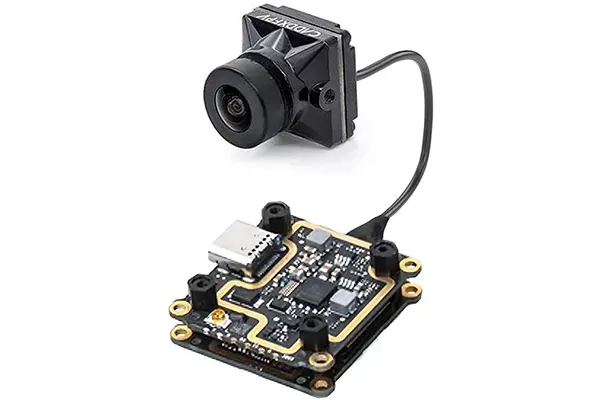
Find this product at these vendors:
RUNCAM
NIGHT EAGLE HD

The Runcam Night Eagle has been the most sought-after low-light analog FPV camera for years. It’s not true zero-lux night vision, but it’s incredibly capable at picking up even tiny amounts of ambient light and turning it into a flyable image.
Now, the ultimate low-light camera is finally available for the DJI FPV system. The digital Night Eagle for Runcam Link gives the same great low-light performance that analog pilots have enjoyed, but with digital resolution and link robustness.
Find this product at these vendors:
The DJI Goggles 2 refers to the goggles released in late 2022 with the Avata drone. The Goggles 2 are the successor to the DJI FPV Goggles v2. (Can whoever decided to name these products please be fired?) The Goggles 2 are smaller and lighter than the V2 goggles. They’ve got 1080p OLED screens instead of LCD, so the image is richer, brighter, and more saturated. But the main appeal of the Goggles 2 is that they are compatible with DJI’s OcuSync V3 protocol. This protocol has 1080p resolution instead of the 720p or 810p used by the previous generation. And somehow, it has an even better range and penetration!
The Integra is a more affordable version of the Goggles 2, which a few features removed. Whether the Integra or the Goggles 2 is right for you depends on how much you care about those missing features.
- The Integra has the same 1080p 100fps OLED screens as the Goggles 2, so the overall image quality will be the same. The Integra removes the internal focus adjustment of the Goggles 2, although it does come with a set of lenses at various diopter values, that you can install on the goggles. The change in optics also means that the image on the Integra is a little smaller than the Goggles 2 (from 51 degrees FOV down to 44 degrees).
- The Integra has a built-in battery pack that lasts about 2 hours. The pack mounts on the back of the head strap, which balances the weight of the goggles, but also means you’re carrying an additional 200-ish grams on your head. If you run out of juice, you can use a USB power bank to power the Integra. It doesn’t have any DC input like the Goggles 2.
- The Integra replaces the Goggles 2 touchpad with a joystick. Frankly, I think this is an improvement, as the touchpad is kind of finicky to use sometimes.
- The Integra removes the WiFi video streaming capability of the Goggles 2, as well as the built-in head tracker. Frankly, almost nobody was using this anyway, so I don’t think it matters.
As you think about what hardware to get, keep in mind that the Goggles 2 and the V2 goggles both work with the O3 air unit and the older Vista-generation air units. The O3 air unit will do 1080p resolution with the Goggles 2 and 810p resolution with the V2 goggles. The Vista-generation air units will do 720p resolution with both goggles.
So which air unit should you choose? The O3 air unit’s increased resolution has led some pilots to skip the GoPro entirely and use the O3’s onboard recording instead. This saves a massive 120+ grams of weight, and the price of a GoPro when you crash. On the other hand, the dynamic range of the O3 is much worse than the Vista-generation cameras. You can’t see as much shadow detail in the O3 camera, which makes flying into dark areas challenging. And the low-light sensitivity of the O3 is very poor, so if you’re used to flying at dusk, maybe stay away from the O3. The good news is that the Goggles 2 are backward-compatible with Vista-generation air units and cameras, so you don’t have to commit to the O3 if you don’t want to.
Oh yeah… and there are no aftermarket cameras for the O3. You get the O3 camera or nothing.
And if you damage the lens, you basically have to buy a whole new camera, so think about getting a lens protector.
DJI GOGGLES 2
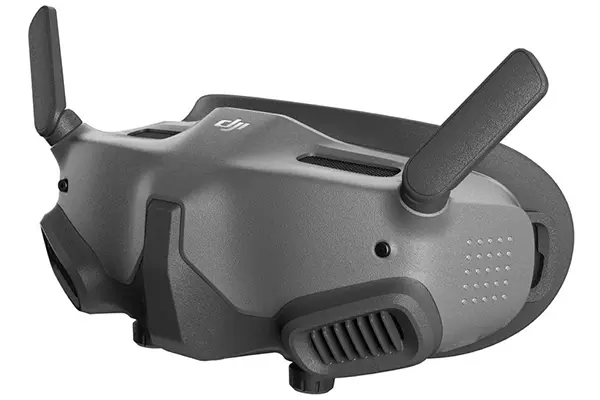
Find this product at these vendors:
DJI GOGGLES INTEGRA
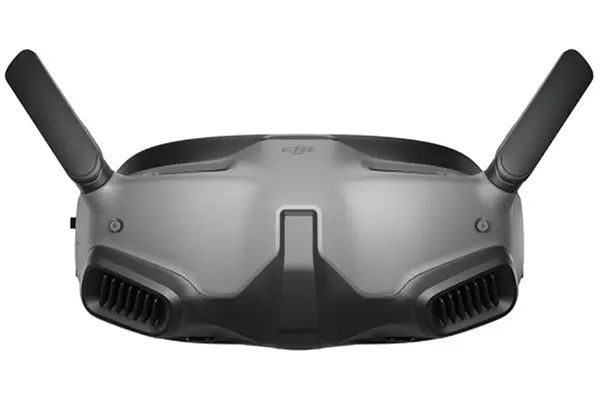
Find this product at these vendors:
DJI
O3 AIR UNIT
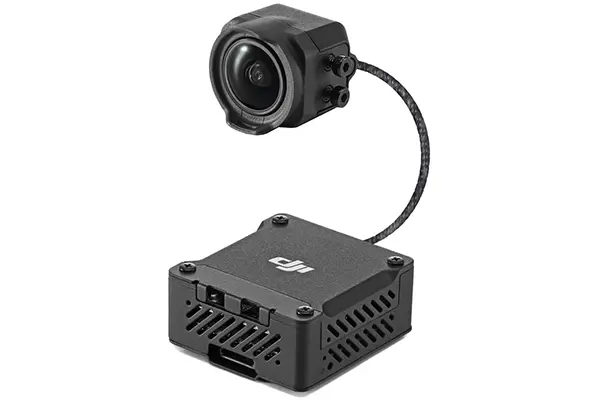
Find this product at these vendors:
IFLIGHT DJI GOOGLES 2
SPONGE FOAM PADDING
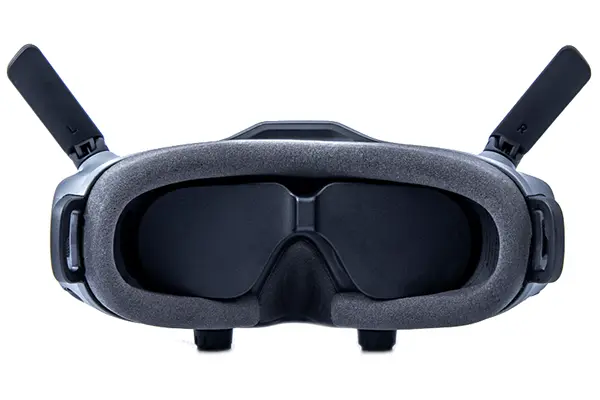
One of the biggest complaints about the Goggles 2 is the fit. If they’re uncomfortable on your face, the upgraded foam may be the solution. And the iFlight foam is one of the best we’ve tried. Especially nice is that it includes foam for the nose-piece so they’ve got a little padding if they touch the bridge of your nose.
Find this product at these vendors:
TRUERC X-AIR ANTENNA
FOR DJI GOGGLES 2
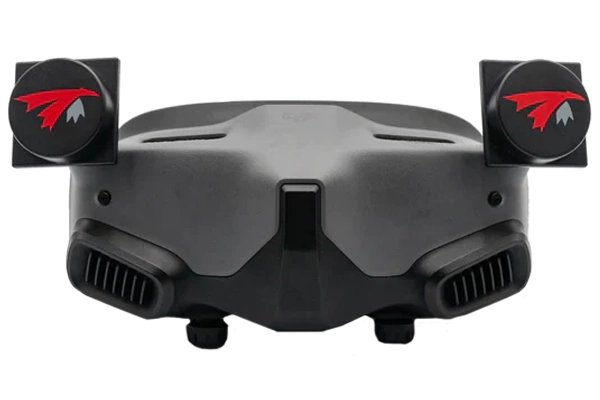
If you are looking to increase the range and penetration of your Goggles 2, these antennas are your best bet. The X-air is a proven design from one of the most respected manufacturers in the FPV space. Unlike the Lumenier adapter, these antennas come with a molded plastic housing that holds them securely in place.
One caveat: You’ll probably need to take these antennas off the goggles when storing them, which will add up wear and tear on the Goggles 2 MMCX connectors. Eventually, this may result in decreased range and penetration, although the exact number of mating cycles isn’t really known.
Another caveat: These antennas are left-hand polarized. The antennas on the O3 are linear polarized. Any time you have polarization mismatch, you’re going to lose some amount of range. So the benefit of these antennas will not be fully realized unless you also replace the antennas on your O3 with left-hand circular antennas.
Find this product at these vendors:
FLYFISHRC
DJI O3 ANTENNA
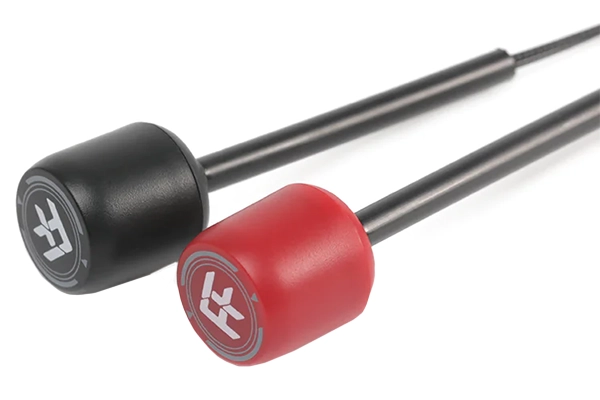
This antenna is a drop-in replacement for the stock antenna that comes on the O3 air unit. The O3 has two antenna connectors, and if you look closely at the stock O3 antenna, it has two wires coming out of it. But it only looks like one antenna! That’s because there are two linear-polarized antennas mounted inside the shell, in a 45-degree orientation to each other.
Most of the time, if you buy aftermarket antennas for the O3, you’ll need to buy two of them. And they’ll be circular polarized, while the Goggles 2 antennas are linear polarized. So you’ll get a little shorter range.
So the FlyFish antenna is basically the only aftermarket antenna that matches the specs of the original O3 antenna. And it’s available in multiple lengths: a stubby antenna for improved durability and an ultra-long version for better range (by moving the antenna further from the body of the quad).
Find this product at these vendors:
The Walksnail Avatar system was made in partnership with Fat Shark, who released their own version of the Avatar goggles as the Fat Shark Dominator. Dominator goggles are identical to Walksnail goggles. The only difference is the color, and who you contact if you need support or repair.
The Walksnail Goggles X is the 2nd generation FPV goggle for the Walksnail system. Here’s what it shares with the original Dominator goggle: 1920×1080 OLED screens at 100 Hz; focus adjustment -2 to +6 diopters; and compatibility with all Walksnail Avatar video transmitters.
The Goggles X solved several issues with the gen-1 Walksnail goggles. The Goggles X has proper HDMI out (not USB-to-HDMI) and HDMI in. This means that it can be used with 3rd party receivers like HDZero, or just plugged in to your computer and used as a display.
The Goggles X also added an AV input, which means they can be used with an analog receiver, although you’ll have to resort to 3D printing to mount the analog receiver on the goggles. The goggles don’t have any module bay for the analog receiver.
The final promise of the Goggles X is that they have a modular radio board, which can be upgraded to a next-gen system that will have 4x the range of the current system. Walksnail says this will release around August, 2024. Our opinion is that you shouldn’t buy products today based on promised upgrades to come in the future. If/when this happens, it’ll be interesting to see how the performance measures up to the promise.
Based on this, you might think the Goggles X are the perfect all-round FPV goggle. They support all three FPV systems (other than DJI). And that’s true, but their analog video functionality is clunky to use. If we had to pick an all-round goggle, we’d lean towards the HDZero goggles. Instead, we prefer to think of the Walksnail Goggles X as the perfect goggle for pilots who mostly fly Walksnail, but maybe want a little analog or HDZero on the side.
WALKSNAIL AVATAR GOGGLES X
Find this product at these vendors:
FAT SHARK DOMINATOR GOGGLES
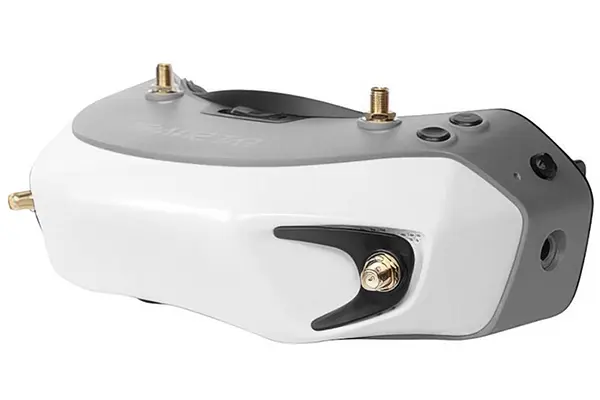
Find this product at these vendors:
The Avatar/Dominator goggle has top-tier specs for an FPV goggle: 1920×1080 OLED screens running at 100 Hz. 46-degree field of view is large enough to be immersive, without overwhelming your peripheral vision. Goggles include focus adjustment for -2 to +6 diopters, so many people will be able to use them without corrective lenses. They support USB-to-HDMI video output, which allows easy mirroring of the video feed to external screens or HDMI capture devices.
One major limitation of the goggles is that they don’t have any secondary video inputs. No AV input for an analog receiver module. No HDMI input for another digital system, or even for using the goggles as a display to play your favorite simulator. If you buy these goggles, you’ll only be using them for this system. And if you want to fly any other system, you’ll need to buy a different set of goggles.
WALKSNAIL VIDEO TRANSMITTERS AND CAMERAS
WALKSNAIL STANDALONE
VRX
The standalone vRX lets any goggle with an HDMI input receive signal from a Walksnail video transmitter. The vRX sends video to the goggles via an HDMI input, so any goggle that can take a 720p or 1080p input is compatible. This is a huge benefit to people who have perfectly good goggles and want to try out the Walksnail system.
The vRX has all the features and performance of the Walksnail goggles, but there are some potential tradeoffs. Some goggles have extra latency on the HDMI input or the screens. Additionally, almost no goggles support the display of a 100fps signal, so Walksnail is forced to operate only at 60 fps, which adds about 10 ms of latency.
Find this product at these vendors:
WALKSNAIL AVATAR
V1 VTX
The Avatar video transmitter supports up to 1200 mW of output power, similar to the DJI system. The camera can be set to either 720p @ 60 fps, 720p @ 100 fps, or 1080p @ 60 fps modes. The 1080p support seems like it would give the system an edge over the DJI FPV v2 system, but the Walksnail system doesn’t show much if any, improvement when switching from 720p to 1080p. This is, presumably, one of those features that Walksnail is still “optimizing”. The Walksnail system also supports 25 Mbps and 50 Mbps channel widths, but as with 1080p, the 50 Mbps mode doesn’t seem to show as much improvement in image quality as would be expected, and the stability of the link even seems to go down sometimes in 50 Mbps mode. For the time being, I fly this system in 720p, 100 fps, and 25 Mbps. In this mode, it’s pretty decent, but I can’t help the feeling that I was promised more.
The Avatar vTX includes two left-hand circular polarized antennas.
The Avatar camera fits in the standard 19mm “mini” size that’s supported by most frames today. The Avatar video transmitter has 25mm square mounting holes. This style of mounting is not directly supported by many frames, although the number is growing slowly. We recommend mounting this vTX using double-sided tape and zip-ties or some other similar improvised method. If you use double-sided tape, make sure to install screws and nuts into the vTX mounting holes, otherwise, the heat sinks will come off in crashes.
Find this product at these vendors:
WALKSNAIL AVATAR
VTX V2
The core features and performance of the V2 Walksnail vTX are the same as the V1, so range, penetration, and image quality are unchanged. The biggest changes are that the V2 can be ordered with 32 GB of onboard video storage compared to only 8 GB on the V1. And the V2 can be ordered with two new cameras: the Pro and the V2.
The V2 camera has similar image quality to the V1 camera. Its big difference is that it has a native 4:3 sensor and supports 4:3 mode, which has a much larger vertical field of view. If you prefer to fly in 4:3, finally there’s a Walksnail camera for you.
The “Pro” camera has a Sony Starvis sensor on it, which gives it extraordinary low-light sensitivity. It provides a flyable 100fps image in near-total darkness. It can output 4:3, but it’s got a native 16:9 sensor, so you don’t get a larger vertical FOV. You just crop the sides of the 16:9 image (pointless).
The V2 camera and the Pro camera also add a gyro sensor so that their footage can be stabilized by the free, open-source GyroFlow software. Be careful because the V2 camera also comes without the gyro, so make sure you order the one you intend to order.
The V2 vTX has solder pads next to the plug, in case the plug breaks off or if you just don’t trust plugs. The V2’s antenna retention screws are normal-sized unlike the microscopic ones used on the V1. The V2 has 20mm mounting holes so it’ll fit more easily in more frames. On the downside, the V2’s main plug and USB plug are different size than the V1, so you won’t be able to swap it into a V1 build without re-soldering the wire harness. Finally, the V2 drops down from two antennas to one, for a simpler install. Surprisingly, this doesn’t seem to have reduced performance at all.
Find this product at these vendors:
Purchase at RaceDayQuads – HD Kit V2 / HD Pro Kit
Purchase at GetFPV – HD Kit V2 / HD Pro Kit
Purchase at NewBeeDrone – HD Kit V2 / HD Pro Kit
Purchase at Rotor Riot – HD Kit V2 / HD Pro Kit
Purchase at Banggood – HD Kit V2 / HD Pro Kit
Purchase at Amazon – HD Kit V2 / HD Pro Kit
Purchase at Flywoo – HD Kit V2 / HD Pro Kit
Purchase at Caddx – HD Kit V2 / HD Pro Kit
WALKSNAIL AVATAR
MINI & MINI-LITE VTX V1 KIT
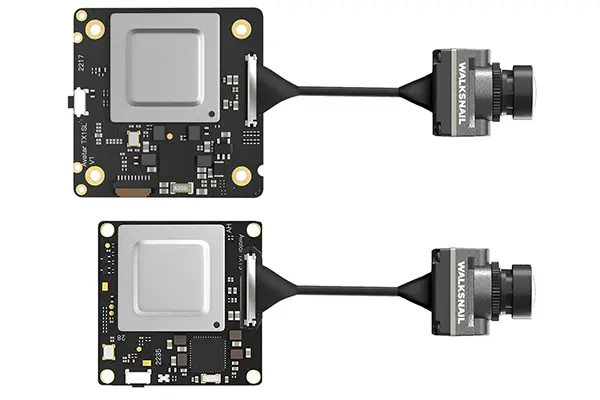
The Mini vTX has the same core features as the full size vTX, except that it only goes up to 350 mW output power. It can be powered from 3.1v to 5v so it can run off a 1S battery or a 5v regulator – but if you run it off a 5v regulator, be careful, because voltage spikes over 5v can kill it!
There are two versions of the 1S Mini vTX – the regular “mini” and the “mini lite”. The regular mini has a heat spreader on the main chip, comes with a circular polarized antenna, and has a 14mm camera. The “mini lite” has no heat spreader, comes with a linear whip antenna, and has a barebones camera that’s intended to mount in a Whoop canopy. The difference between them is that the Mini Lite overheats faster and the Mini Lite is only ~7 grams while the Mini is ~9 grams.
Find this product at these vendors:
WALKSNAIL AVATAR
VTX V1 & CAMERA KITS
The Avatar vTX can be purchased with two different cameras: a micro camera (19mm wide) or a nano camera (14mm wide). If you’re not sure, look up what size camera your quadcopter frame is designed for, or just put a ruler between the camera plates and measure. Most quads down to about 3″ prop or 95mm wheelbase use micro cams. Smaller ones usually use nano cams.
Find this product at these vendors:
WALKSNAIL AVATAR
HD PRO CAMERA
What makes this camera stand out is its Sony Starvis sensor, which gives it exceptional low-light sensitivity. It’s not a true thermal camera, so it can’t fly in total darkness, but even on a moonlit night, or under street lights, it gives a flyable image. Amazingly, you don’t really give up anything in terms of daylight performance. This is the best all-around camera for flying under mixed lighting conditions, such as in dark bandos or at dusk.
The Pro camera also has a built-in gyro sensor, which means its footage can be stabilized using the free, open-source GyroFlow program.
Although the Pro camera supports 4:3 output, its sensor is native 16:9, which means the 4:3 mode just chops off the edges of the screen. It doesn’t actually increase your field of view.
Find this product at these vendors:
WALKSNAIL AVATAR
HD CAMERA V2
This camera’s killer feature is its native 4:3 sensor. This gives it a much larger vertical field of view, which some FPV pilots strongly prefer. The camera can output 16:9, in which case it will chop off the top and bottom of the image.
This camera can be ordered either with or without a built-in gyro sensor. The gyro sensor means that its footage can be stabilized using the free, open-source GyroFlow program.
Find this product at these vendors:
WALKSNAIL ANTENNAS AND ACCESSORIES
TRUERC X-AIR 5.8 MK2
PATCH ANTENNAS
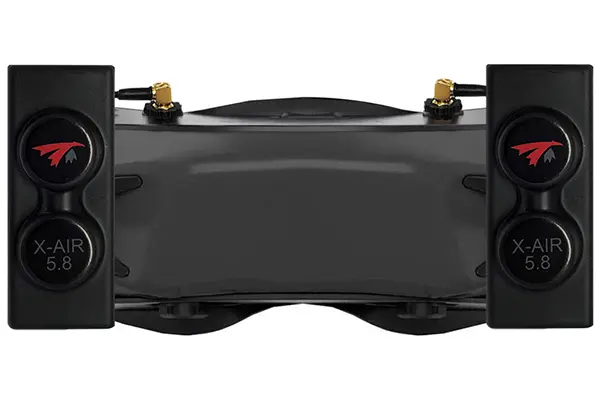
Don’t let the fact that this antenna is labeled as “for DJI” throw you off. It’s perfect for use with the Walksnail system as well. This antenna has two X-Air Mk2 antennas mounted in a single housing, with two antenna plugs coming out the back. So you’d buy two of these and screw them into the two left and two right connectors on your Walksnail goggle.
The advantage of this approach is that you have four directional antennas on your goggle, which gives you the best possible range and penetration in front of you, but reduced range and penetration to the sides and back. You can still fly to the side and rear of yourself, you just won’t get as much range in that direction as you would with a pair of omnidirectional antennas on the goggles.
If you usually stand at the edge of your flight area and face into the flight area, flying in front of yourself, then these antennas are a fantastic choice. If you usually stand in the middle of the flight area and fly all around yourself, then you’d be better with one of the other sets on this page that combines two directional and two omnidirectional antennas.
Confusingly, the antenna comes with one SMA and one RP-SMA connector, but the goggles have all RP-SMA. You will need this adapter to attach the antennas to your goggles. The antennas include a right-angle adapter, which works for the DJI goggles, but the Walksnail goggles need a straight adapter. Make sure to install the adapter on the front-facing goggle connector.
Find this product at these vendors:
TRUERC X-AIR 5.8 MK2
PATCH ANTENNAS WITH OMNI’S
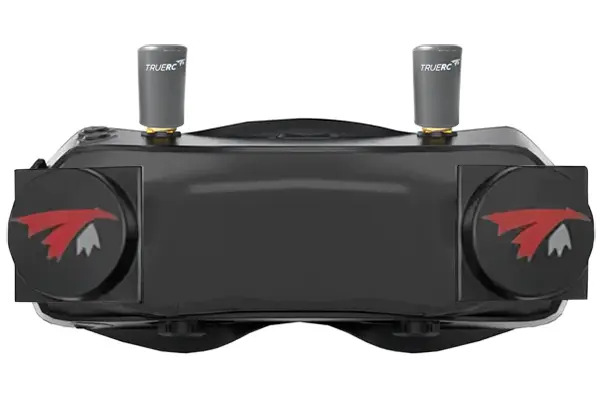
The stock antennas that come with the Avatar goggles don’t give the best possible range and penetration. The Fat Shark Dominator goggles don’t come with any antennas at all! We recommend the TrueRC X-Air Mk2 and Stubby antennas for most people looking to upgrade. The combination of a higher-gain directional antenna on front of the goggles with an omnidirectional antenna on top gives a good balance of improved range and penetration in front of you, without compromising too much coverage to the side or behind.
TrueRC sells these antennas in a combo with either Stubby or OCP omnidirectional antennas. The Stubby antennas let you easily store the goggles in a case or bag without removing them. The OCP have longer stalks, which lets them stick up above your head and gives better coverage. Other stores may not sell the X-Air in a combo, and you may need to buy the omni antennas separately.
Find this product at these vendors:
TRUERC X2-AIR 5.8 MK2
PATCH ANTENNAS
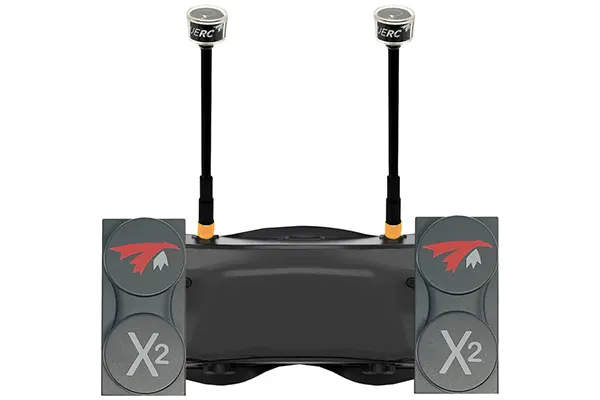
The X2-Air Mk2 is an even higher gain than the X-Air, giving 13 dBi of gain instead of the X-Air’s 10 dB. This equates to about 1.4x the range in open air. The tradeoff is slightly reduced vertical beam width, so if you tend to drop your head while you fly, you’ll want to break that habit.
The X2-air is best with a set of omnidirectional antennas on the top two connectors of the goggles. In theory, you could use four X2-airs, but it’d be pretty difficult to mount them on the goggles. Some stores sell the X2-air in a combo with a set of omni antennas; other stores require you to buy the omnis separately.
These antennas are sold in either RH (right-hand) or LH (left-hand) polarization. Walksnail video transmitters are all shipped with LH antennas, so you would buy LH for the goggles as well. Only buy RH if you know for a fact you have been buying RH antennas and swapping them out for the factory antennas on your video transmitters.
Find this product at these vendors:
HDZero uses a completely different method of encoding and compressing the video signal from DJI and Walksnail. The argument goes that DJI and Walksnail have higher latency, but what matters more is that the latency is always changing, so the pilot can never learn exactly how much to “lead” the quadcopter to compensate for the latency. In addition, DJI and Walksnail lose video frames when the signal gets weaker, which makes the video appear to “skip” or “stutter”. The result is a less connected feel and less precise control of the aircraft.
HDZero has very low latency–faster than DJI and Walksnail, and even faster than some analog cameras. More importantly, its latency is constant. And when the signal gets weak, the video never stutters or skips. Instead, small blocks of the image turn white, similar to the way an analog signal gets staticky.
This focus on smooth and low-latency video is why HDZero is the HD video system that racers prefer (although most of them are still on analog). In addition, HDZero was designed to be compatible with the frequencies and timing systems used by analog pilots, so it fits right in at races, and it doesn’t require any new training or procedures to avoid interfering with analog pilots at your flight line.
The tradeoff for HDZero’s approach is that it gives less range and penetration than DJI and Walksnail, watt-for-watt. And some people feel that the “sparkly static” way that the HDZero signal breaks up is less usable than the “blocky” way that DJI and Walksnail degrade. You can watch videos and try to compare for yourself, but unfortunately, it’s difficult to judge until you’ve tried to actually fly an aircraft through the environment using both systems.
HDZero has focused on making video transmitters for many different needs. There’s a 1 watt vTX for freestyle pilots and an ultra light-weight vTX and camera for tiny whoops. Although some people have managed to build smaller quads around DJI and Walksnail vTX, HDZero is the only digital FPV system that even approaches the lightweight and small size of analog.
HDZERO GOGGLES
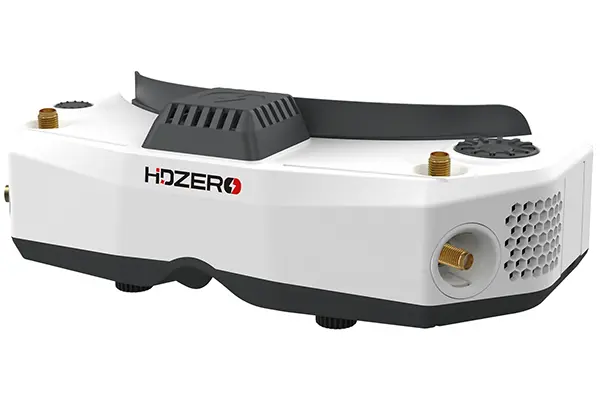
If you use the HDZero system, the HDZero goggle is, hands-down the best experience you can get. But the HDZero goggle may also be the best analog goggle, and the best Walksnail goggle as well.
For users of the HDZero system, the HDZero goggle’s 90 fps screens mean it is the only goggle that lets you use the 90 fps camera. This, combined with the goggles’ end-to-end transmission sync, means you get 14 ms consistent, locked latency with 90 fps updates, for the smoothest, most connected feel of any FPV system today (lower latency even than analog)!
Analog pilots can plug their receiver module into a module bay that mounts on the side of the goggles. This isn’t just an afterthought, though. The HDZero goggles have comb filter and high-quality deinterlacer for the best-looking analog video you’ve ever seen.
If you want to use the Walksnail standalone vRX, the HDZero goggles have an HDMI input that supports the 720p/100fps mode. They are the only FPV goggles to support 100fps input, which gives lower latency than the 60fps modes supported by all other FPV goggles. The HDZero goggle doesn’t have quite as low latency as the Walksnail Avatar goggles though, so if you fly the Walksnail system exclusively, you should get the Avatar goggles. The HDZero only makes sense if you want to fly Walksnail and some other system like analog or HDZero.
There are SO MANY reasons to choose these goggles that I can’t sum them up. You should definitely watch my full review, linked below.
Find this product at these vendors:
HDZERO STANDALONE RECEIVER MODULE
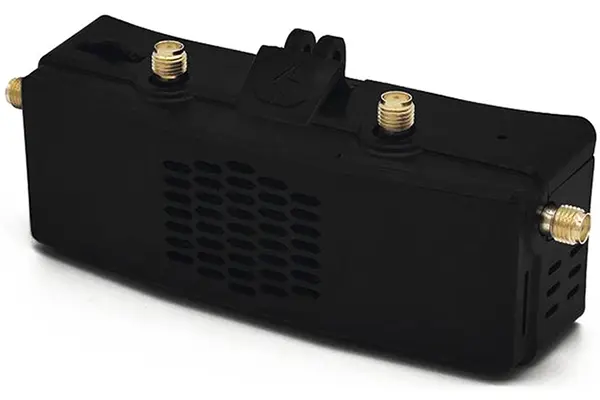
Most users of the HDZero system will purchase this standalone receiver module, then connect it to a separate set of FPV goggles or another display device using its HDMI output. The HDZero receiver only outputs digital video via HDMI, so legacy displays that lack HDMI input won’t work. The receiver has a bracket to mount to the front of Fat Shark goggles. 3D-printed brackets have been designed for other goggles.
We say “most users will purchase this receiver” because there are a few screens and goggles that were produced in the past with built-in HDZero receiver. Examples of this include the Fat Shark Scout HD and the ByteFrost screen. These haven’t been manufactured for some time, but if you come across them, they’re fully compatible with modern HDZero video transmitters.
The HDZero receiver module requires four antennas, which must be purchased separately. There are some recommendations below.
Find this product at these vendors:
HDZERO VIDEO TRANSMITTERS AND CAMERAS
HDZERO FREESTYLE V2 VTX

Like its predecessor, the Freestyle vTX V2 outputs up to 1 watt of power, for the best range and penetration available in the HDZero system. The big change with the V2 is the form factor. Now it’s similar in size to the DJI O3 and the Runcam Vista, so it fits easily into the 20mm mounting in the back of most 5” and larger frames. Bear in mind, though, that it’s slightly larger than a Vista, so make sure to measure before you commit.
The Freestyle V2 vTX can be ordered by itself or in a “kit” with a Runcam Nano90 camera.
Find this product at these vendors:
HDZERO RACE V2 VTX
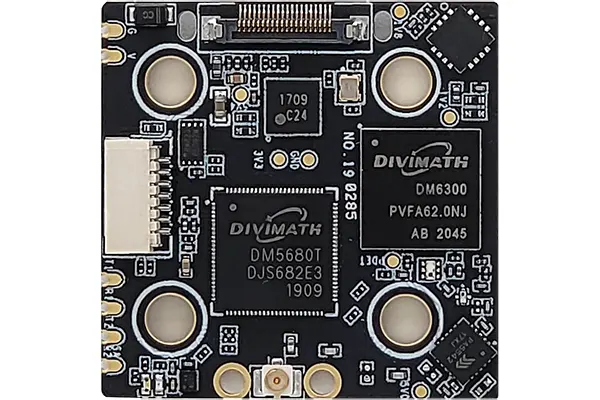
The Race vTX is made to fit the 20mm mounting pattern used on smaller, lighter racing drones. It maxes out at 200 mW output power, which gives it less than half the range and penetration of the 1W freestyle vTX. But racers typically run at 25 mW anyway, to avoid interfering with each other. And race courses are typically designed to accommodate this output power. The Race vTX is also designed to minimize the use of very small surface-mount components, which is intended to increase durability.
HDZero cameras must be purchased separately from the vTX. The Race vTX does not include an antenna; you will need to source your own. We have some suggestions linked below.
Find this product at these vendors:
HDZERO WHOOP VTX
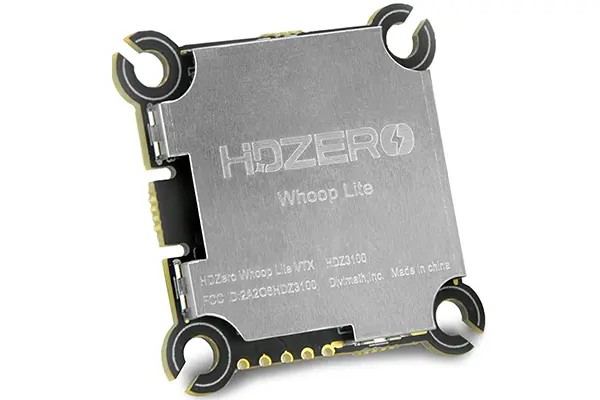
The HDZero Whoop vTX is designed to fit into a Tiny Whoop build. These small 65mm wheelbase quadcopters typically use diagonal 25mm mounting holes for their flight controller and ESC; the HDZero Whoop vTX mounts right on top. But the Whoop vTX is useful for larger builds too! Many types of lightweight quadcopters up to about 3” prop size use Whoop-style mounting for their electronics, and the HDZero Whoop vTX will fit perfectly in these builds.
The Whoop vTX supports up to 200 mW output power. The camera and antenna must be purchased separately (see below).
Find this product at these vendors:
HDZERO
WHOOP LITE BUNDLE
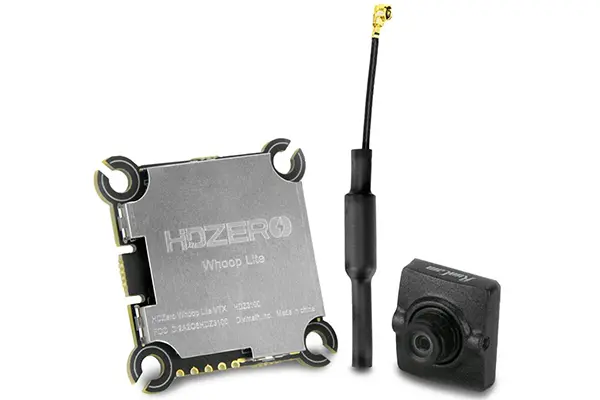
The HDZero Whoop Lite bundle includes an ultra-light HDZero vTX and camera, specifically designed to be mounted onto a “tiny whoop” style quadcopter. The mounting matches the 25mm diagonal mounting holes typically used in this class. The Nano Lite camera weighs only 1.5 grams and fits in the 14 mm-sized mountings that most Whoop canopies expect. The vTX can output up to 200 mW of power.
Most people will purchase this vTX and camera in a bundle, however, the Whoop vTX and camera can be purchased separately if desired. The Bundle includes a dipole antenna.
Find this product at these vendors:
RUNCAM
HDZERO V2
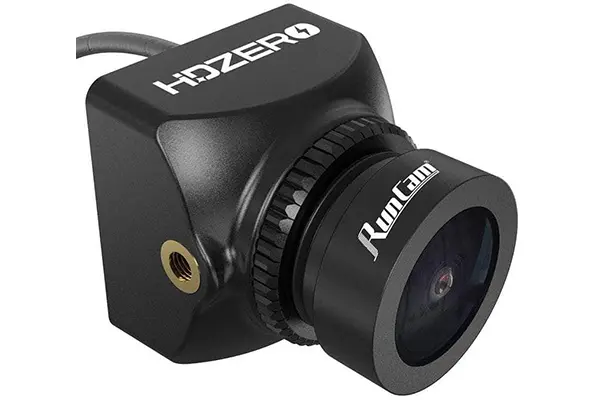
Most image sensors used in FPV cameras today are native 16:9 aspect ratio. So if you prefer to fly in 4:3, you end up cutting off the sides and get a smaller field of view. The Runcam HDZero V2 has been optimized for use when flying in 4:3 aspect ratio. Although the sensor is 16:9, the lens’s coverage circle has been designed to cover a 4:3 square out of the center of the lens. This means that you get a generous 155° diagonal field of view. It can be switched to 16:9 mode as well, for those who prefer it, but the FOV will only be 145°.
The other thing that sets this camera apart is its extreme configurability. Image settings like color balance, sharpness, and more are at the user’s fingertips.
The HDZero V2 is available in two sizes: Micro (19mm wide) and Nano (14mm wide). The Micro camera has a larger M12 lens, while the Nano has an M8 lens. Although the sensors are the same, the larger lens of the Micro camera gives it slightly better optical image quality. Buy whichever one your frame is designed to fit.
Find this product at these vendors:
RUNCAM HDZERO
NANO 90
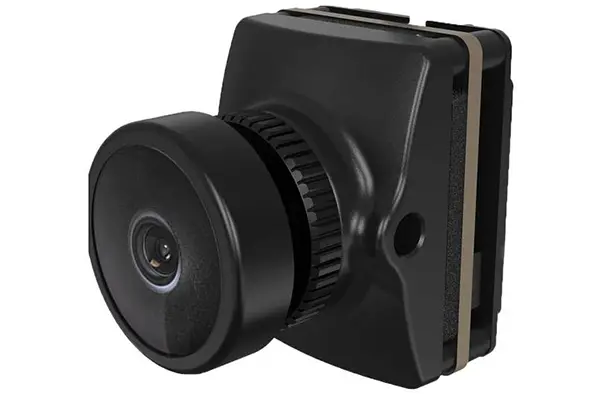
HDZero’s biggest advantage has always been its low latency and smooth, jitter-free framerate. The Nano 90 camera takes this to the next level with 90fps framerate (50% more than other cameras). When used with the HDZero goggles, this brings the glass-to-glass latency down to just 4 ms – faster than even most analog cameras! Bear in mind that currently, only the HDZero goggles support the 90fps mode. If you’re using any other HDZero receiver, you can use this camera, but there won’t really be any advantage compared to the Runcam Micro camera.
This camera completely blew me away when I first tried it. I’ve flown low-latency, low-framerate analog systems before, and I’ve flown high-framerate, high-latency digital systems before. The combination of low latency and high framerate is really something else. You can check out the video below to see my reaction, but honestly, you have to try it for yourself to see if you agree with my reaction.
Find this product at these vendors:
HDZERO ANTENNAS AND ACCESSORIES
TRUERC X2-AIR 5.8 MK2
PATCH ANTENNAS
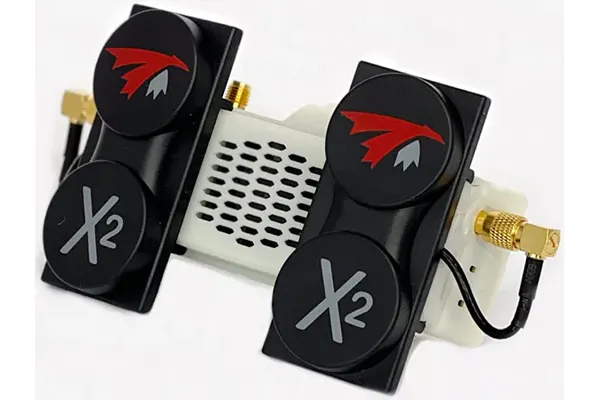
The X2-air Mk2 is an even higher gain than the X-Air, giving 13 dBi of gain instead of the X-Air’s 10 dB. This equates to about 1.4x the range in the open air. The tradeoff is slightly reduced vertical beam width, so if you tend to drop your head while you fly, you’ll want to break that habit.
Another disadvantage of the X2-air is its larger size. Fortunately, the mounting rail system on the HDZero goggles makes them easy to remove when it’s time to put them away.
TrueRC sells these antennas in a combo with the OCP omnidirectional antenna. These have longer stalks, which lets them stick up above your head and give better coverage, but they would have to be removed before storing the goggles. You could choose to buy Stubby antennas separately if you prefer.
These antennas are sold in either RH (right-hand) or LH (left-hand) polarization. Most people using HDZero will have RH antennas on their video transmitters, and so they would buy RH for the goggles as well. Only buy LH if you know for a fact you have been buying LH antennas for your video transmitters.
Find this product at these vendors:
TRUERC X-AIR 5.8 MK2
PATCH ANTENNAS
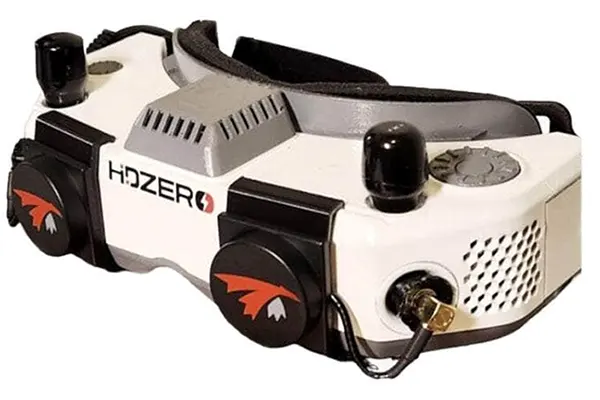
Putting a set of directional antennas on the front of your goggles gives improved range and penetration wherever you’re facing. The best all-around performance of the HDZero system is achieved by combining a set of omni antennas on top of the goggles with a set of directional antennas on the front. The omnis give “ok” coverage to the sides and back; the directional antennas give “wow” coverage in front.
The HDZero goggles have mounting rails on the front for accessories. These TrueRX antennas are designed to mount on those rails for a super low-profile setup that tucks easily into a bag or case.
TrueRC sells these antennas in a combo with the OCP omnidirectional antenna. These have longer stalks, which lets them stick up above your head and give better coverage, but they would have to be removed before storing the goggles. You could choose to buy Stubby antennas separately if you prefer.
These antennas are sold in either RH (right-hand) or LH (left-hand) polarization. Most people using HDZero will have RH antennas on their video transmitters, so they would buy RH for the goggles as well. Only buy LH if you know for a fact you have been buying LH antennas for your video transmitters.
Find this product at these vendors:



